Ring Alarm Review
A DIY home security system with impressively low monthly monitoring

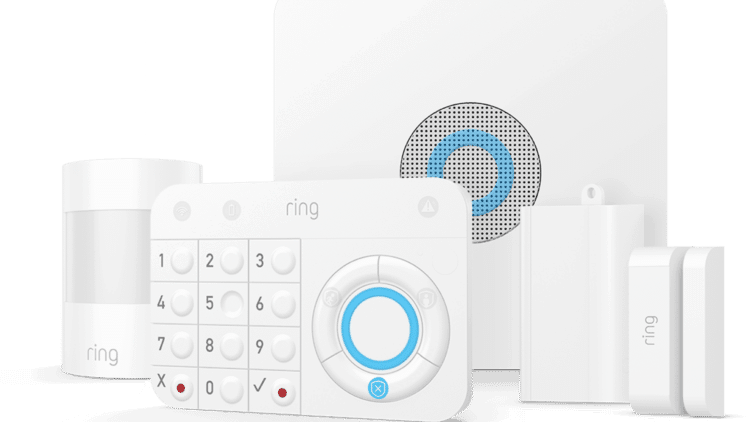
SafeHome.org may receive compensation from some providers listed on this page. Learn More
We may receive compensation from some providers listed on this page. Learn More
A DIY home security system with impressively low monthly monitoring


Ring was one of the first companies to release a highly popular video doorbell, and since then has taken the industry by storm, offering high-quality, low-cost home security equipment to fit nearly every need.
Today we’re covering Ring Alarms third generation of alarm systems. We spent over 100 hours testing the newer alarm. The goal was to see if this uber-popular wireless security system is worth the money.
So is the third generation of the Ring Alarm system better than the previous iterations? What new features are there? Does Ring still stand out from the crowd, or are there better options out there? We’ll answer all of that and more here.
Pro Tip: Ring recently released the Ring Alarm Pro system with built-in eero Wi-Fi 6 router that protects your home from digital threats. They’re also taking the show on the road, releasing a dash cam to keep you safe while you’re driving.
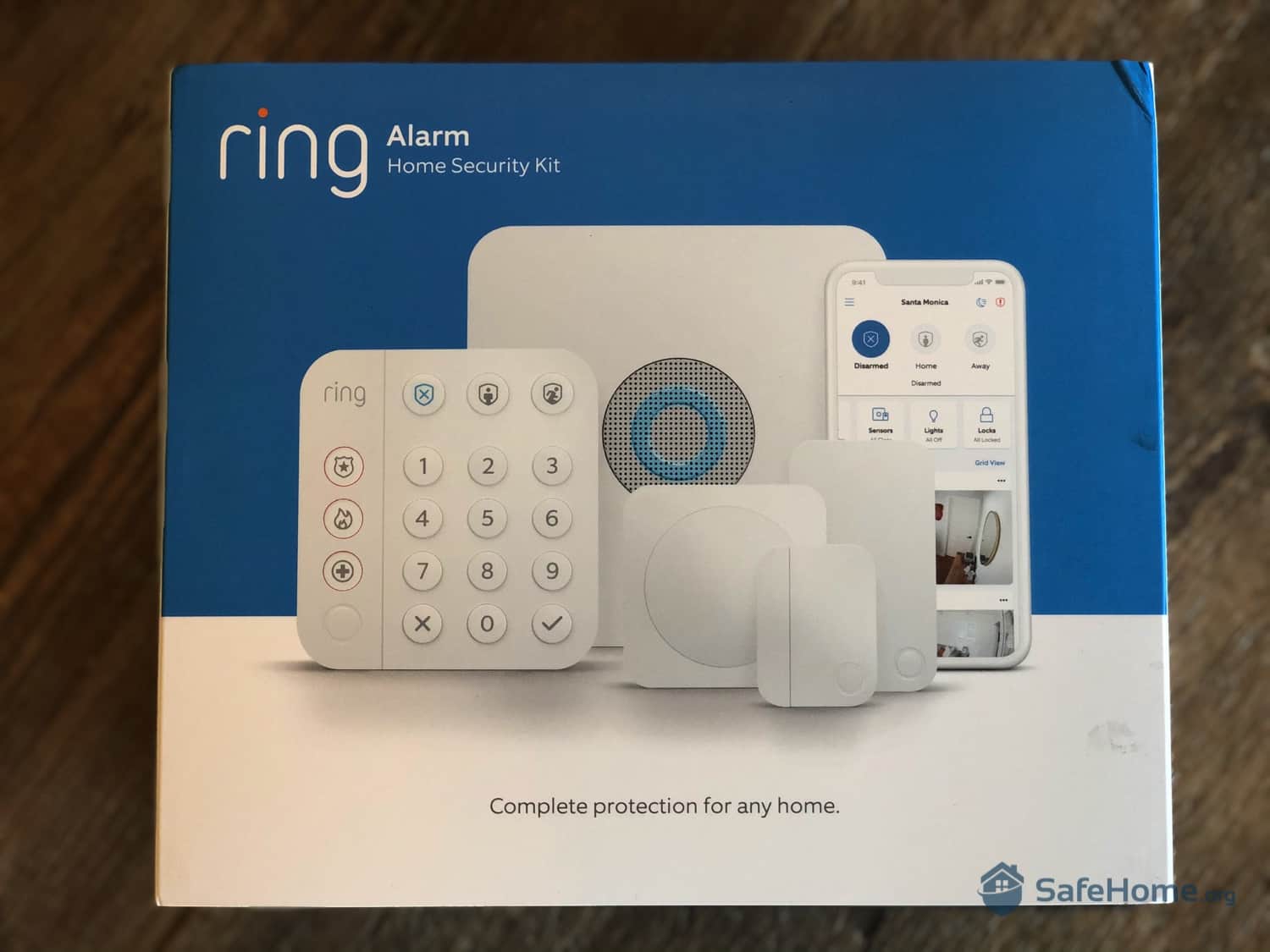
Ring Alarm (2nd Gen) Packaging
Check out more recommendations from the SafeHome team:
The long and short of it is this: Ring makes easy-to-use, easy-to-afford, DIY-friendly home security products. If you’re looking for comprehensive coverages with a little bit of tech flair here and there, Ring’s a great option. Is it the highest functioning system we’ve ever seen? No. Is it enough to protect most households? Probably.
That said, you don’t have to live in a bad neighborhood to be concerned about crime. It happens everywhere, even if it’s something as minor as a package being stolen off your porch. But I wanted a security system that would sound the alarm if a bad guy tried to break in. Thankfully, the new Ring Alarm showed a lot of promise right out of the box.
A little history before we start: The Ring Alarm system was released in 2018 and the first generation showed great promise. Ring then further improved the system in 2020 when it released the second generation and currently available Ring Alarm.
Besides aesthetic improvements, the new second generation Ring Alarm offers quick access to police, medical, and fire responders through the keypad. We’ll touch on those improvements in a bit.
Ring wasn’t done just yet. In 2021, Ring launched the Ring Alarm Pro not as a replacement for the Ring Alarm, but as an additional option. The Ring Alarm Pro features a base station that doubles as a Wi-Fi router. It also comes with nifty features when paired with a Ring subscription plan.
We went on to test the Ring Alarm (2nd generation) and here’s everything you should know.
I went with an eight-piece kit, which at the time was $249.99. It’s now on sale for $187.49, so if you’re interested in picking one up yourself, now might be a good time to consider buying.
Back to my experience, though.
The new sensors are a bit smaller than the first-generation sensors, but most impressively, the new keypad is now almost half the size of the original.
The kit (pictured below) included a base station, a keypad, four contact sensors, a motion sensor, and a range extender.
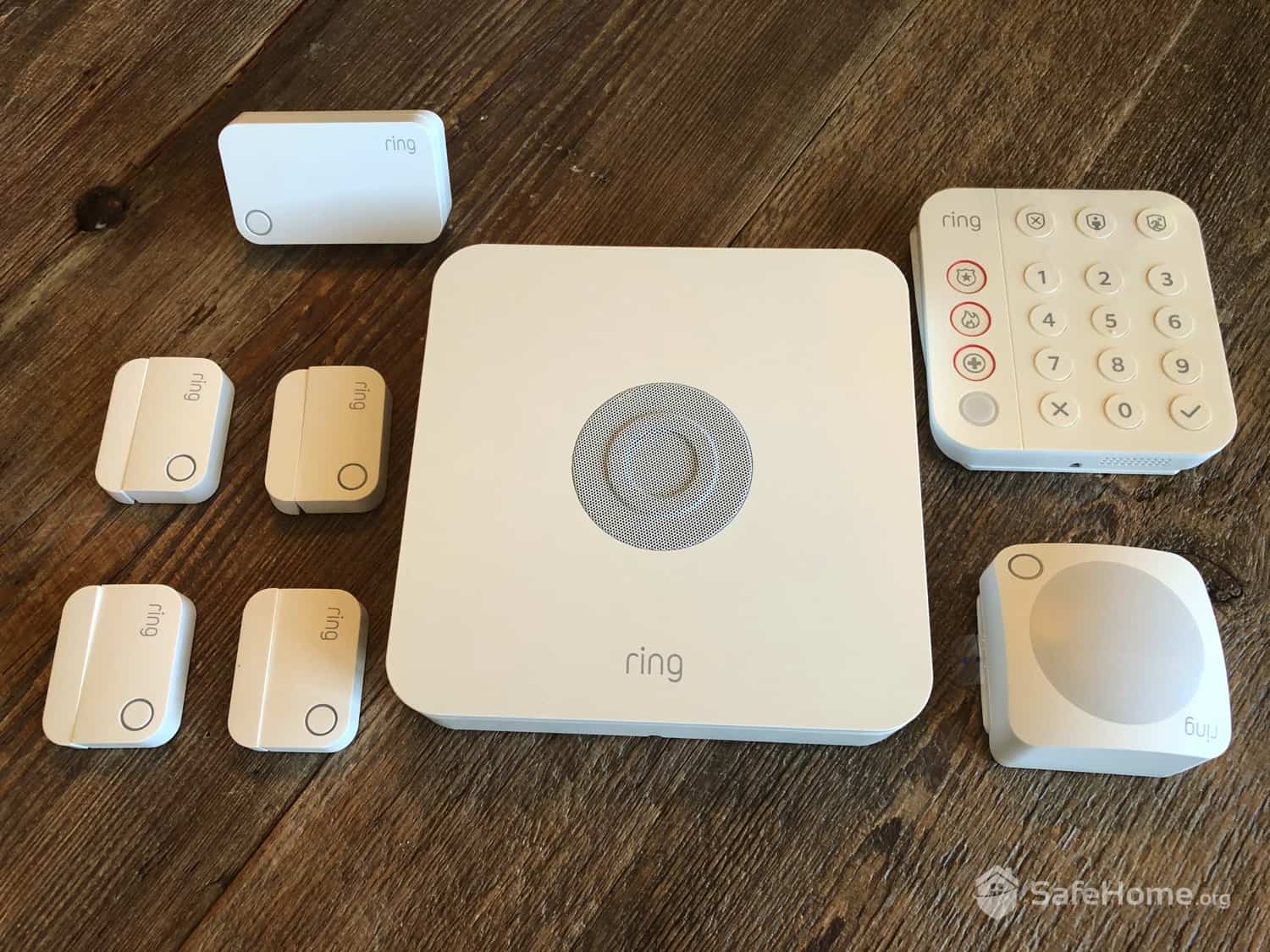
Ring Alarm (2nd Gen) Equipment
You can now choose between kits with 5, 8, 10, or 14 devices, with options to add Ring cameras, doorbells or both at discounted prices. Prices range from $199 for the five-piece kits to about $500 for 14-piece kits with additional accessories.
If you’re shopping for Ring Alarm systems, however, don’t forget to check out Ring’s featured deals. These deals change all the time, but if you’re lucky, you can get up to $100 off of alarm system and camera bundles.
The setup is pretty fast and easy. To start, Ring will ask you to download the Ring – Always Home app. After that, just click on “Set Up a Device.” You’ll want to choose the fourth option down: “Security Devices.”
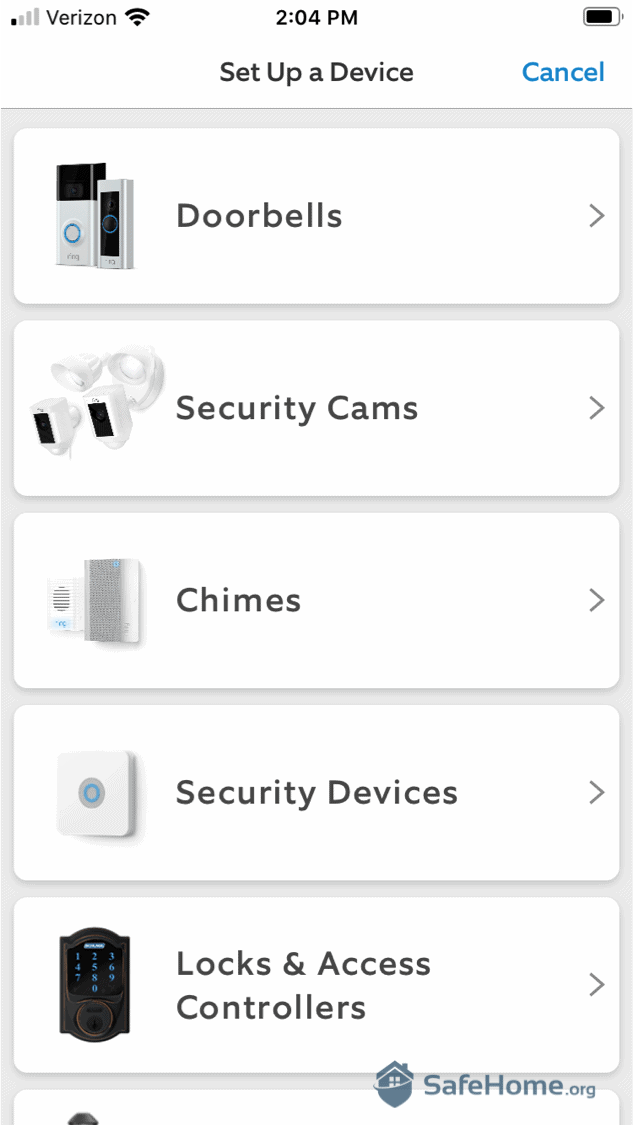
Ring Alarm App – Device Setup
Ring’s step-by-step instructions are dialed-in. In the app, be sure to check out the two-minute videos that walk you through each part of the setup process. They’re great.
Pro Tip: If you have little ones in the house, don’t set up your new alarm system while they’re napping. False alarms happen, chimes go off, etc. It never ends well …
Now, they say setup only takes 10 minutes — but that’s not true. It took almost five minutes just for the base station to connect to the Wi-Fi and do a software update. So, set aside 30 minutes for installation. (C’mon, you can catch up on “Schitt’s Creek” later.) Setup is easy, but take your time.
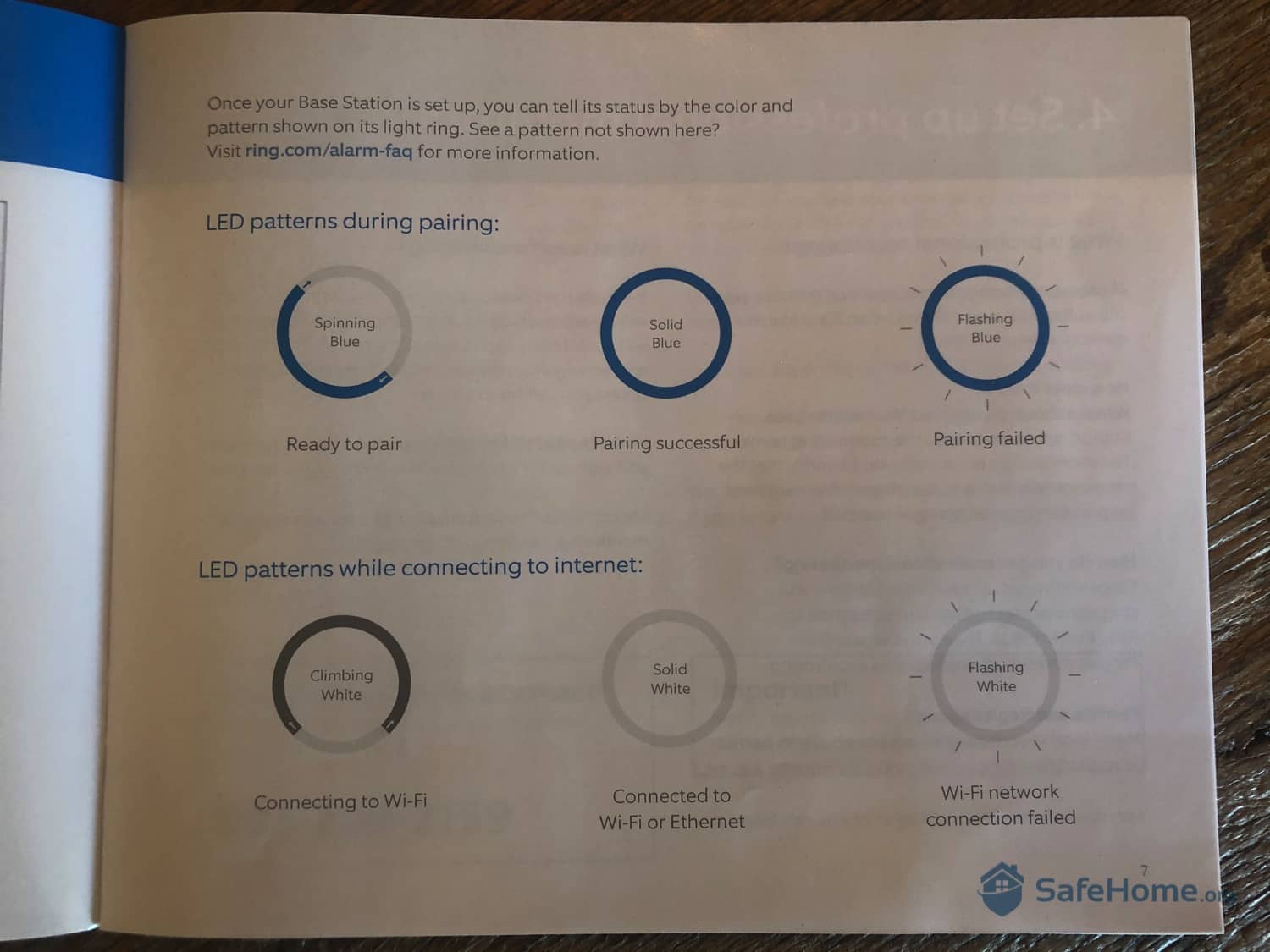
Ring Alarm Pairing
One of the first things you’ll notice about the second generation Ring Alarm system is the sensor redesign. It’s a major improvement, and you can tell Ring put some thought into it. They’re smaller and way more streamlined than the original sensors. They also go up easily using double-sided tape, which saves your walls from yet another hole you’ll have to fill in later. Check out the side-by-side photo below of the new and old Ring Alarm sensors.
Another upgrade, which has something to do with sensor pairing, is that the second generation now has a LED light that flashes every time you pair a new sensor. This wasn’t available in the first generation, which made it harder to determine if pairing a sensor was successful. It’s the little things…
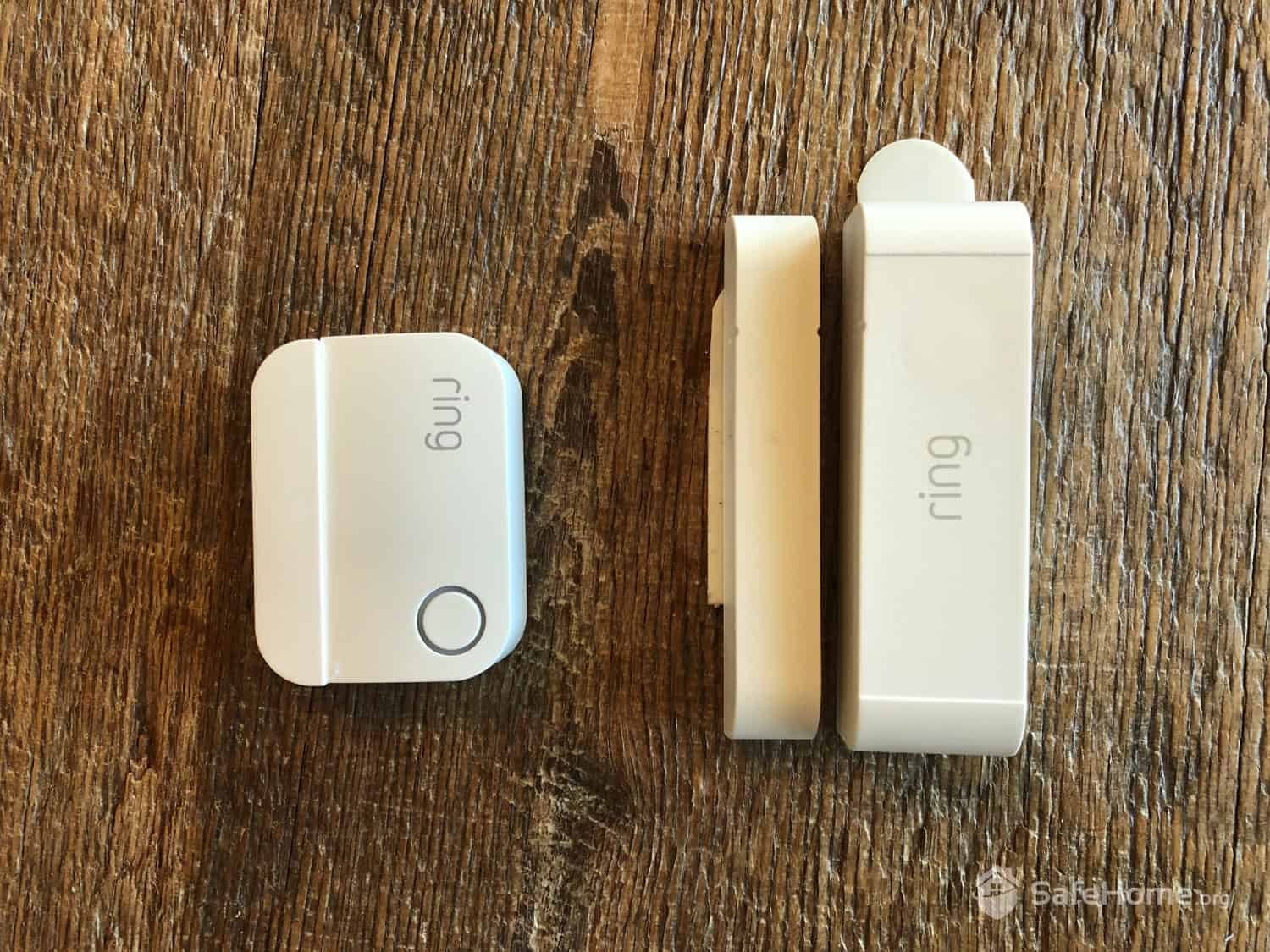
Ring Alarm Sensors – 1st Gen (right) vs 2nd Gen (left)
Note that the old sensors (right) have tiny notches that you have to line up. But not the new ones! That gives you more flexibility when it comes to mounting them.
I actually kept a few of the old Ring sensors up, because they were needed to protect the upstairs windows. Thankfully, all of the 1st Gen and 2nd Gen Ring products work together on the Z-Wave network.
FYI: If you have an old Ring Alarm, you can use a combination of your old sensors and new sensors. All devices that run on the Z-Wave network are compatible and integrate seamlessly into the Ring Z-Wave base station. Easy peasy.
While you’re getting used to the system, it’s a good idea to place a pillow over the base station to muffle the siren. That is, if you want to keep your sanity while learning the ropes. The siren is ear-piercing, which is great in case of a break-in. It can be a real crime-stopper.
Overall, the new Ring Alarm is pretty easy to install. The installation compares well to other top DIY home security brands like SimpliSafe and Frontpoint.
Now, if you’d prefer a security system with professional installation, we recommend checking out Vivint or ADT — two of our top-rated security systems.
Every Ring system comes with a 30-day free trial of Ring Protect Pro. This is Ring’s monitoring plan that costs $20 per month, or $200 a year if you want to save. It’s worth the price, in our opinion, as other alarm companies charge as much as $60 for monitoring alone.
For $20, Ring’s monitoring center will monitor your Ring Alarm. In the event a burglar targets your home, they will be notified and they’ll alert you, as well as call emergency services if necessary. We recommend getting a monitoring plan, as it offers backup protection against break-ins and burglaries.
That said, Ring’s monitoring is not the most reliable or fastest service, as you’ll soon see.
If you’d rather self-monitor your system for free, just skip the trial and you’ll have self-monitoring by default (using your smartphone). Just keep in mind that if you self-monitor, police won’t be dispatched if there’s a break-in. You’ll have to call 911 yourself, and that’s a heavy load to carry.
Did You Know? Ring is one of a handful of DIY home security companies that allows self-monitoring. While self-monitoring is free (no monthly charge), keep in mind you won’t have a professional monitoring center backing your system. If you’re curious, we put together a rundown of what we believe are the top security systems without monitoring in 2025.
I spent a total of 96 hours testing the system and really getting into the nitty-gritty. Expect to spend a couple of hours using the Ring app to get your bearings, then a couple of days to master it. The learning curve is smooth, but there are a handful of important things you should know about. (Like how not to have a siren-induced heart attack at 11:58 p.m.)
First off, when you sign up for 24/7 monitoring, you’ll go into “practice mode” for seven days. Now, I love that Ring gives users time to learn the ropes of the new system, but I don’t like that practice mode lasts seven days. Sure, it might take a few days (and a few false alarms!) before you fully understand how it all works, but by day three, you’ll wish you had the pros backing you up already.
As for the siren, it’s pretty darn loud at 104 dB. But if you live in a bigger home, you may be less-than-impressed with the volume. I put the base station in my office downstairs, and though I could hear the alarm upstairs, it wasn’t very threatening. My toddler actually slept through the alarm on day two of testing! Not a peep! To really scare off intruders, it would be nice to have 110 dB or more.
Pro Tip: Plug in your Ring base station somewhere central in your home. This will help the siren to penetrate all rooms. Although Ring’s siren is louder than some of the competition, like Vivint’s 100 dB siren, it could be louder.
Ready to laugh at my expense? Don’t worry, there’s an important lesson here. On day three of using the new Ring Alarm, my family went to sleep thinking the house was safe and secure. Then it happened. We woke to the siren blaring at 11:58 p.m. (It’s plenty loud when you think your life is in danger.) The culprit: The front door sensor had simply fallen off.
Chock it up to user error. You see, Ring really drills home in their setup instructions that you need to clean the door trim before installing the sensor. I forgot to do that. The two-sided tape is sticky, but not if it’s blocked by a layer of dust. Lesson learned.
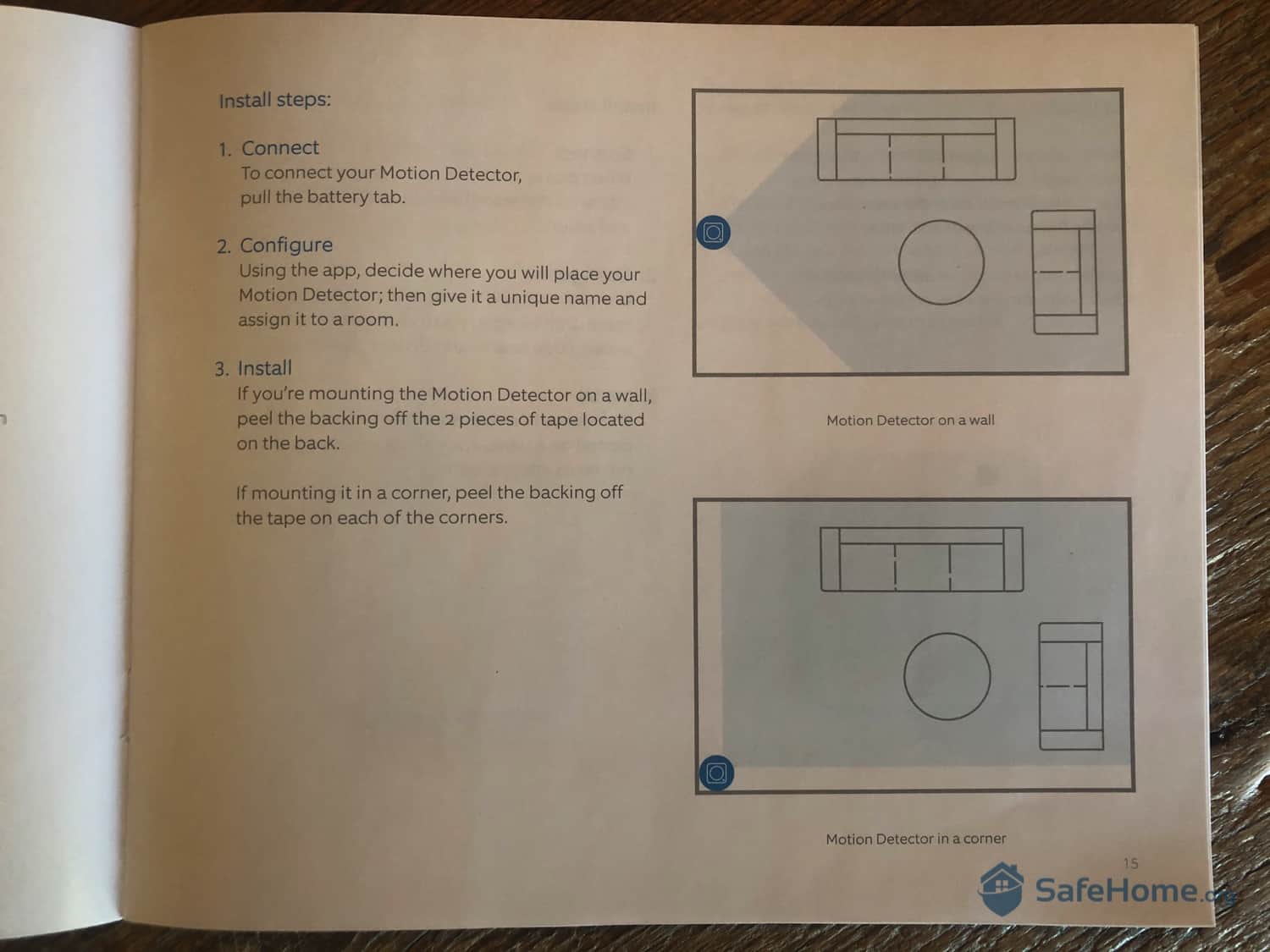
Ring Alarm (2nd Gen) Installation Steps
One thing I think you’ll like about the Ring Alarm is the entry and exit delays. This is a common feature in security systems that basically gives you enough time to enter your home and disarm the system before it triggers an alarm. That said, it also gives burglars a chance to break-in, take some stuff, and get out before cops are called.
What sets apart Ring’s exit and entry delays is that you can only get them on a sensor that’s set to the “main door.” If, during the delay, you trip a hallway motion sensor, the alarm will trigger immediately. That’s a nice little touch that shows how much thought Ring put into creating a security system to protect people’s homes without inconveniencing them.
That being said, there’s one thing about the entry and exit delays I didn’t like. The factory delay is set to 60 seconds, which is extremely long. That’s enough time to enter your home and make a ham sandwich before disarming the alarm. (Yes, I tried it.) Imagine what a burglar can steal in 60 seconds! If you don’t have mobility issues, 20 seconds is more than enough delay.
FYI: Burglars spend, on average, eight to 12 minutes in a home. Many are in and out in as little as two minutes flat! With that in mind, I recommend reducing the Ring Alarm delay to 10-20 seconds. Here’s how: In the Ring app, go to “setting” → “modes” → “delays”
You can also connect your Ring Alarm to your Amazon Echo devices for hands-free voice control. (You can even add an Amazon Echo to your alarm system order for only $10!) It only takes a minute to set up your Echo in the app. Then you can walk around your home like a boss, ordering Alexa to arm and disarm at your will. Talk about living a modern lifestyle.
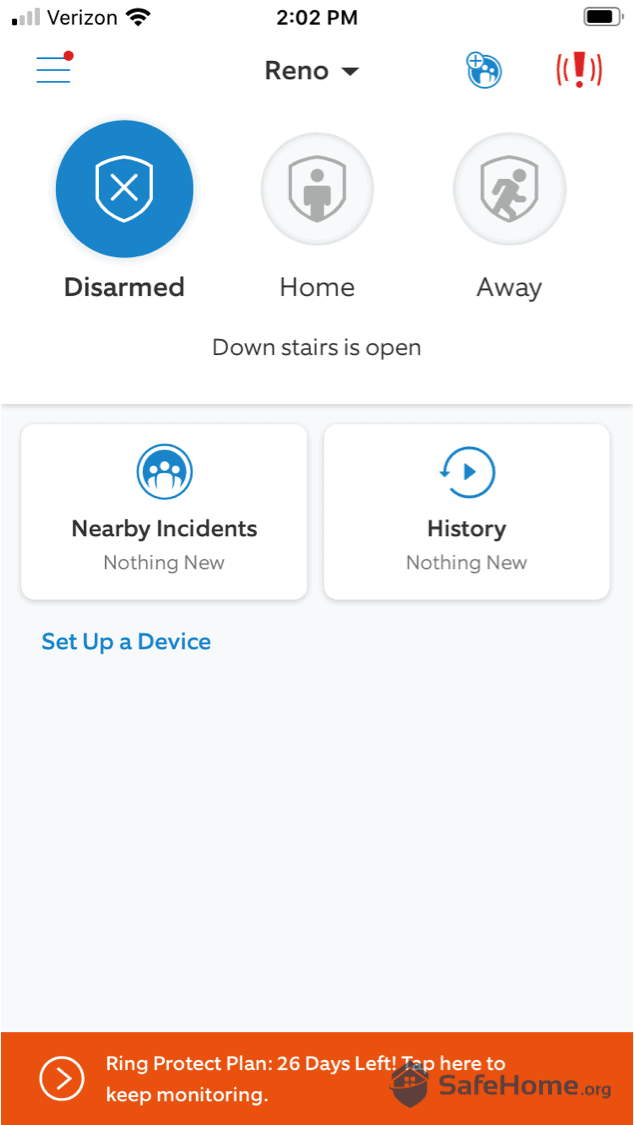
Ring Alarm App Dashboard
The app that controls the popular Ring doorbell and Ring cams is the same app that controls the Ring alarm. So if you have multiple Ring devices, you’ll be able to manage them all in one convenient place. That’s one of the best things about Ring. If your alarm detects an intrusion, for example, you can immediately switch over to live camera feeds for visual confirmation. And while you’re there, you can use two-talk — a feature available on every Ring camera — to drive away the intruder.
One app feature you may appreciate is the panic button, symbolized by the little ((!)) in the upper-right corner of your dashboard (pictured below). Pressing the button triggers the loud siren, which makes this feature great for deterring crime if you suspect an intruder has broken into or is breaking into your house. It’s comforting to know help is just a tap away.
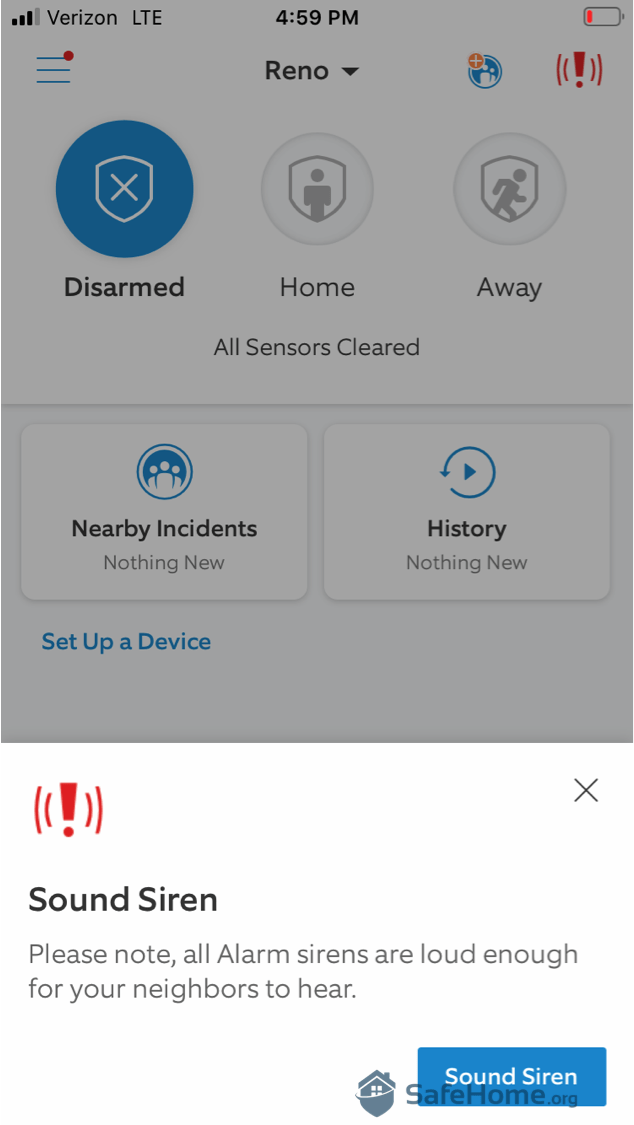
Ring Alarm Sound Siren
Another thing you’ll find handy: the ability to customize modes for individual sensors. For example, if you like to go out onto your back deck when the weather is nice, you can switch your back door sensor to “unarmed” in the app. Then you’ll be able to come and go without setting off the alarm, while the rest of the house remains perfectly secure. (This functionality is pretty common for security apps, but it’s still nice to see.)
Ring also does a good job with instant alerts. You can really fine-tune the push alerts that are sent to your smartphone. It’s worth mentioning that even with push alerts disabled, you’ll still get a notification from Ring if your alarm is tripped. There’s no way to turn this off. (And why would you?) So, even if you’re in the Maldives on vacation and someone breaks into your home, you’ll get an alert almost immediately. Thankfully, this is standard in the industry.
Did You Know? Ring “Neighbors” is built right into the Ring app. You’ll find it on the dashboard, under “Nearby Incidents.” This section of the app lets you keep tabs on crime in your area, and other less threatening things like lost kittens.1
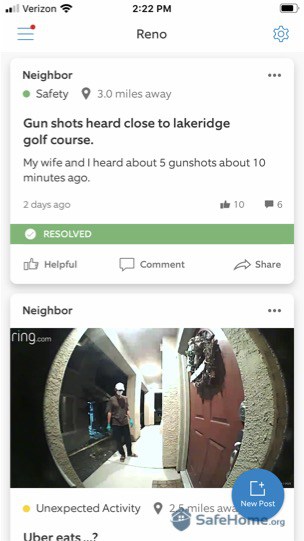
Ring Alarm App Dashboard
Of course, it’s nothing compared to the touch-screen panels offered by ADT and Vivint, but Ring’s new keypad isn’t half-bad for a push-button panel. It’s smaller than Ring’s original keypad, lasts up to six months on the battery, and has three new buttons: police, fire, and medical. Similar to the ((!)) feature in the app, these three buttons on the keypad will only contact the monitoring center if you have a Ring Protect Pro plan. Otherwise, they’re just loud buttons.
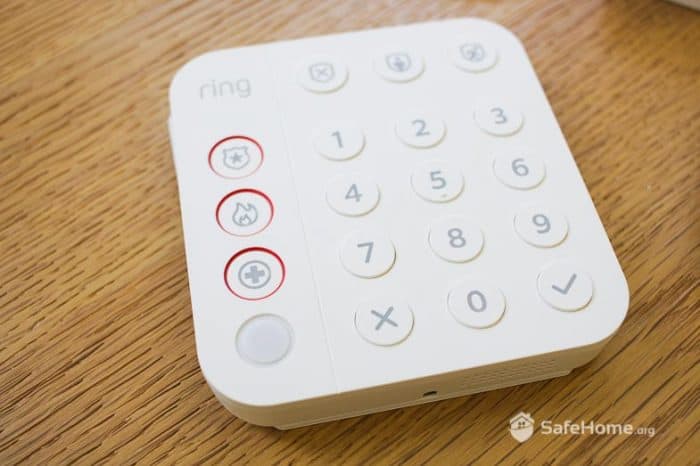
Ring Keypad
One thing to note: When you go to disarm your system using the keypad, enter your PIN code AND press the shield with an “X” on it. If you forget to press the shield, trust me, it’s a very “alarming” mistake.
So, yes and no. There are a few things to consider before springing for professional monitoring. First, it costs $20. This is one of the best price points in the industry, but it still stings a little when you consider it used to be half that. Oh well, the times they are a changing.
Now also consider Ring won’t alert authorities until at least 30 seconds after an alarm triggers. When seconds might count, 30 seconds sure sounds like a lot. While it will certainly cut down on false alarms, we’re not sure waiting is the best solution.
Pro Tip: If you have Ring monitoring, you’ll need to give a verbal passcode to the Ring agent when your alarm goes off. It’s easy to forget your code when they put you on the spot, so make it memorable! Your emergency contacts will have to remember this passcode, too. So drill, drill, drill!
One of Ring’s latest features is a “Duress Code,” which is a covert distress signal, like an SOS.
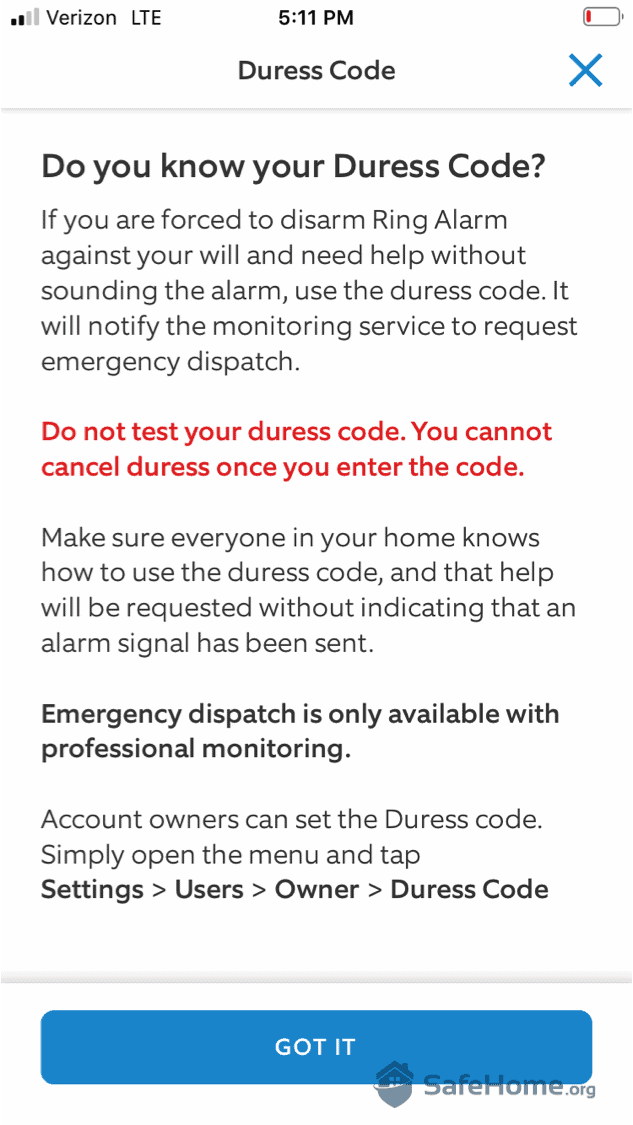
Ring Alarm Duress Code
If you’re ever forced to disarm your system during a home invasion, simply punch in the duress code. The alarm will stop sounding, but sure enough, the monitoring center will send police to your home immediately. All the while, the bad guys think they’re home free. It’s a great feature. Keep in mind, this only works if you have Ring Protect Pro!
Pro Tip: Ring now sells outdoor contact sensors for $49.99, which is something new for the home security industry. So if you want to protect your whole property — think outdoor gates, utility sheds, guest-houses, etc. — then you should consider purchasing these useful add-ons.
After trying out the newest Ring Alarm system, I do have a few gripes. None of these are deal breakers, but Ring has some room for improvement.
Unfortunately, I just can’t recommend Ring’s motion sensors. What I didn’t like about it was its narrow field of vision, creating blind spots on either side of the sensor. The range and responsiveness weren’t very good either.
I was able to fix the problem somewhat by entering into the sensor’s test mode, but even when it was functioning as well as I could get it to, it still totally missed my dog. Even in so-called “high-detection” mode. That didn’t inspire a whole lot of confidence.
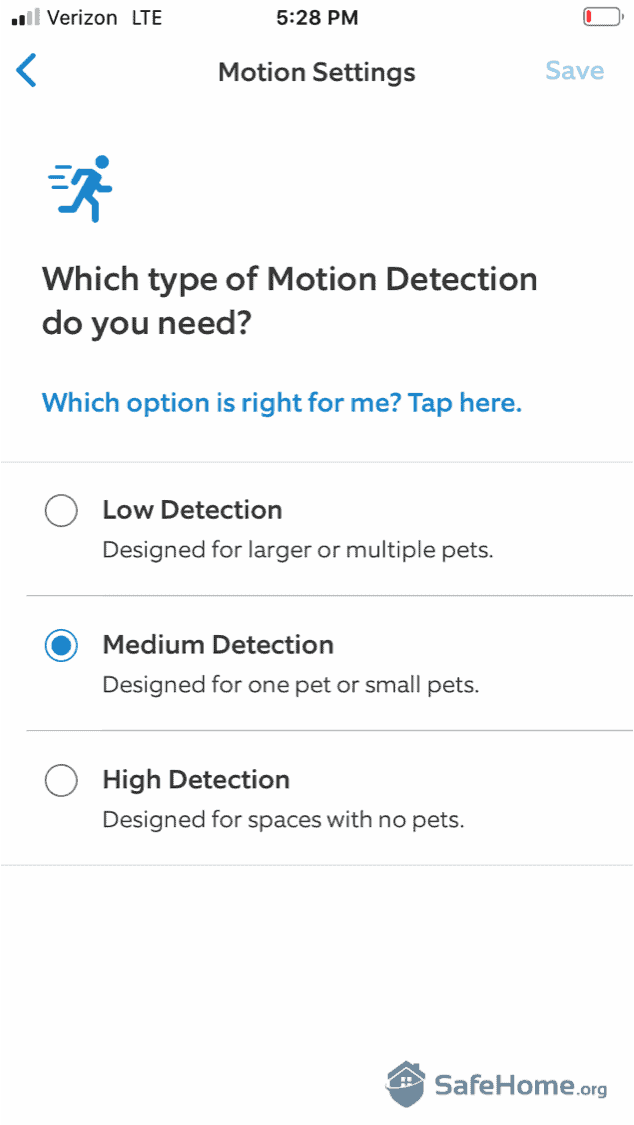
Ring Alarm Motion Settings
When you disarm the system, the base station practically yells “DISARMED,” which can be disturbing. More than once, it prematurely woke our toddler. (A fate worse than death.) And when leaving a window open at night, Ring says, “SENSORS REQUIRE BYPASS … HOME AND ARMED.” So if you’re looking for stealth, this isn’t it. It would be great if Ring offered silent arming/disarming.
Those keypad panic buttons mentioned earlier are nice to have, but you have to hold them down for a full three seconds in order for them to work. That may not sound very long, but it sure is if your house is on fire, or if there’s a prowler breaking in. A two-second delay would be better.
There’s a full line of Ring Doorbell Cameras and Ring Security Cameras to protect your home. They work nicely with Ring’s alarm systems, and you’ll be able to control all of your devices in the same Ring app. If you’re a current Ring Doorbell user, a Ring Alarm system is a great choice.2 It just makes sense to keep everything on one platform. If you’re curious about other Ring products, check out the stellar Ring Video Doorbell Pro and the Ring Floodlight Cam.
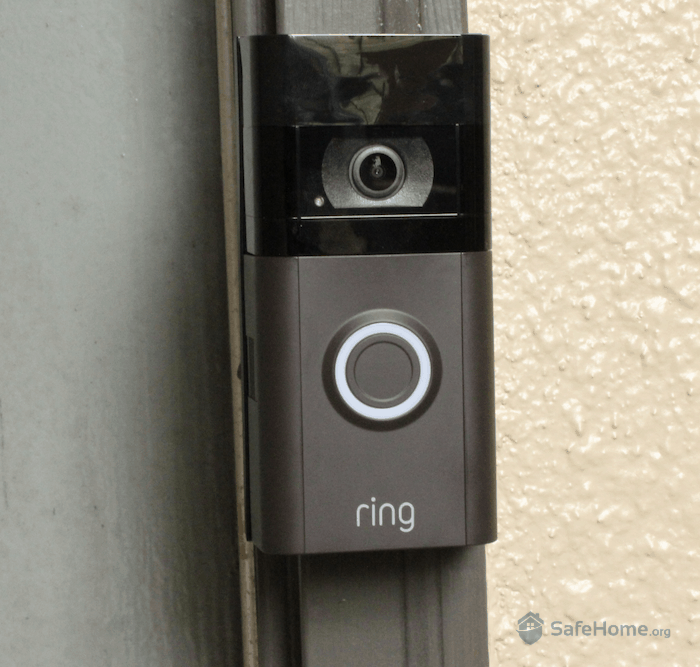
Ring Video Doorbell 3, Installed
Ring is incredibly affordable. To put things in perspective, Ring’s most expensive kit costs half the price of Vivint’s cheapest system. So Ring is one of the best values on the home security market. Check out their latest prices below, and for a closer look at Ring Alarm costs, head over to our Ring Alarm Pricing page.
| Ring Alarm Kit | Regular Price | Sale Price |
|---|---|---|
| Alarm Security Kit — 5 Pieces | $199.99 | $149.99 |
| Alarm Security Kit — 8 Pieces | $249.99 | $187.49 |
| Alarm Security Kit — 8 Pieces plus Indoor Cam | $239.99 | $224.99 |
| Alarm Security Kit — 10 Pieces | $279.99 | $194.99 |
| Alarm Security Kit — 14 Pieces | $329.99 | $247.49 |
Ring offers several ways to customize your system, but you do have to start with one of their alarm kits in order to get the base station that controls everything. (It’s not sold separately.) Once you have your kit, you can add extra devices, like environmental sensors to alert you to smoke/fire, carbon monoxide, frozen pipes, and flooding. You can also buy additional contact sensors, motion sensors, keypads, etc.
| Ring Accessory | Price |
|---|---|
| Chime Pro | $59.99 |
| Solar Panel | $59.99 |
| Smoke Alarm and CO Listener | $34.99 |
| Motion Detector | $29.99 |
| Contact Sensor | $19.99 |
| Panic Button | $29.99 |
| Outdoor Contact Sensor | $49.99 |
| Glass Break Sensor | $39.99 |
| System connectivity | Wi-Fi (primary), cellular (backup) |
|---|---|
| Monitoring type | Professional or self-monitoring |
| Response time | 30+ seconds |
| Installation type | DIY |
| Time to install | 10-30 minutes |
| Professional installation | Available via third party (OnTech) |
| Central control device | Base station with wireless keypad |
| Indoor and outdoor cameras | Yes |
| Sensors | Motion and entry sensors |
| Coverage | 2,000+ sq. ft. |
| Compatible smartphone app | iOS and Android |
| Warranty | 1 year |
| Monitoring contract | Month-to-month |
| Cost of professional monitoring | $20 per month |
| Equipment cost | Starting at $200 |
| Financing options | 3, 6, or 12 months |
| Release date | 2020 (2nd gen) |
The new Ring Alarm packages do a great job at essential home protection, and for the price — between $200 and $330, it’s easy on the wallet too. The monitoring packages are inexpensive, and everything here just screams “value.”
Just don’t expect to get high-tech features, as Ring Alarm is lean when it comes to home automation. Ring systems integrate with Amazon Alexa, smart locks, and Z-Wave compatible devices, but that’s it. Think of the Ring Alarm as basic intruder protection.
That said, Ring’s doorbell cameras and their lineup of Ring Cams are some of the best devices in the industry. I definitely recommend looking into those for outdoor security. But as far as alarm systems go, there are better options on the market. If you’re willing to spend a little more money, you should definitely check out Frontpoint. (Here’s our Frontpoint review.) Or, for a similar price to Ring, you can pick up a starter kit from SimpliSafe. Either way, you have options!
We spend hundreds of hours testing each security system, but the actual process is even longer. We start with thorough research of available security systems that meet our high standards — high-quality equipment, reliable monitoring, and strong software and app performance.
Next, we purchase the security systems and install them (or have them installed) in our home. This gives us a chance to see how smoothly the installation goes. From there, we assess how each security system protects our home. During this phase of testing, we try out every component and feature, from the control panel or hub to the security sensors and cameras. We also simulate break-ins to see how the systems respond to real-life security threats. And if professional monitoring is available, we get a chance to see how quick the response time is.
Our testing process goes beyond just testing the system though. We keep each system for up to a month or more to assess the user-experience and spot any additional strengths and weaknesses we might have missed during the initial testing. Once we know what it’s like living with the product, only then do we offer up our ratings and recommendation.
Yes, Ring has a 30-day refund policy. They also offer a 12-month limited warranty. If you stay subscribed to the “Standard” or “Premium” plan, you’ll gain extended warranties on eligible devices.
Yes, Ring has a range of wireless products that are not only easy to set up, but don’t require any effort to hide unsightly wires.
No, like most DIY home security systems, Ring is easy to install. We used the Ring app to follow the step-by-step instructions and were up and running in around 30 minutes.
Yes, Ring is compatible with Alexa. Both Ring and Alexa are owned by Amazon, so it only makes sense that they play well together.
Ring’s equipment bundles start from $244.95. You’ll also need to subscribe to a Ring Home subscription, which starts from $4.99 per month. If you want professional monitoring, you’ll need to upgrade to the “Standard” or “Premium” plan and pay an extra $10 a month for the service.
Haselton, T. (2019, August 3). Everyone's talking about this Amazon app that lets police see camera footage — here's what it's like. CNBC.
https://www.cnbc.com/2019/08/02/amazon-ring-neighbors-app-sends-video-to-police-departments.html
Read, M. (2020, February 13). What It's Like to Own an Amazon Ring Doorbell Camera. New York Magazine.
https://nymag.com/intelligencer/2020/02/what-its-like-to-own-an-amazon-ring-doorbell-camera.html
Bishop, T. (2019, April 5). Shark Tank’s billion-dollar blunder: How startup Ring went from TV rejection to Amazon acquisition. GeekWire.
https://www.geekwire.com/2019/shark-tanks-billion-dollar-blunder-startup-ring-went-tv-rejection-amazon-acquisition/